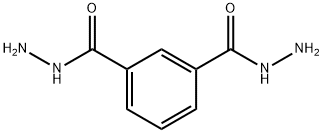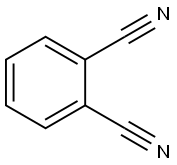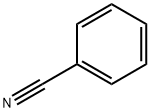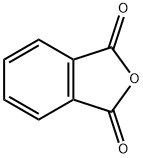1,3-Dicyanobenzene
Synonym(s):3,3′-Dichlorobenzaldazine;Benzene-1,3-dicarbonitrile, 1,3-Dicyanobenzene;Isophthalodinitrile;Isophthalonitrile;NSC 67224
- CAS NO.:626-17-5
- Empirical Formula: C8H4N2
- Molecular Weight: 128.13
- MDL number: MFCD00001795
- EINECS: 210-933-7
- SAFETY DATA SHEET (SDS)
- Update Date: 2025-01-27 09:38:02

What is 1,3-Dicyanobenzene?
Description
1,3-Dicyanobenzene appears as white, crystalline or flaky solid with an almond-like odor. mp: 161-162 °C (sublimes) Density 1.28 g/cm3 (at 25 °C). Insoluble in water. Soluble in benzene and in acetone. Used as an intermediate in the manufacture of polyurethane paints and varnishes, pharmaceuticals, and agricultural chemicals.
Chemical properties
off-white to light brown solid
The Uses of 1,3-Dicyanobenzene
1,3-Dicyanobenzene was used in the synthesis of oxazolines and 1,3-bis-(4,4-dimethyl-2-oxazolinyl)benzene.
The Uses of 1,3-Dicyanobenzene
An intermediate in the manufacture of paints, varnishes, and agricultural chemicals.
Definition
ChEBI: Isophthalonitrile is a nitrile. It is functionally related to an isophthalic acid.
General Description
White, crystalline or flaky solid with an almond-like odor. Mp:161-2°C (sublimes) Density 1.28 g cm-3 (at 25°C). Insoluble in water. Soluble in benzene and in acetone. Used as an intermediate in the manufacture of polyurethane paints and varnishes, pharmaceuticals, and agricultural chemicals.
Reactivity Profile
1,3-Dicyanobenzene is a combustible solid. Emits toxic fumes of NOx and CN- when heated to decomposition. Incompatible with strong oxidizing agents.
Health Hazard
m-Phthalodinitrile is a skin irritant in animals.In humans there have been no reports of adverse effects. The probable reason for lack of systemic effects is that aromatic, unlike aliphatic, nitriles do not liberate cyanide in the body.
Flammability and Explosibility
Not classified
Safety Profile
Poison by ingestion. An eye irritant. When heated to decomposition it emits toxic fumes of NOx and CN-. See also NITRILES.
Properties of 1,3-Dicyanobenzene
| Melting point: | 163-165 °C(lit.) |
| Boiling point: | 288 °C |
| Density | 0,992 g/cm3 |
| vapor pressure | 13.332Pa at 50℃ |
| refractive index | 1.6231 (estimate) |
| Flash point: | 288°C |
| storage temp. | Store below +30°C. |
| solubility | 0.7g/l |
| form | Flakes |
| color | White to tan |
| Water Solubility | 0.7 g/L (20 ºC) |
| BRN | 1072209 |
| Exposure limits | ACGIH: TWA 5 mg/m3 NIOSH: TWA 5 mg/m3 |
| CAS DataBase Reference | 626-17-5(CAS DataBase Reference) |
| NIST Chemistry Reference | 1,3-Benzenedicarbonitrile(626-17-5) |
| EPA Substance Registry System | 1,3-Dicyanobenzene (626-17-5) |
Safety information for 1,3-Dicyanobenzene
| Signal word | Warning |
| Pictogram(s) |
 Exclamation Mark Irritant GHS07 |
| GHS Hazard Statements |
H302:Acute toxicity,oral |
Computed Descriptors for 1,3-Dicyanobenzene
New Products
Indole Methyl Resin tert-butyl 9-methoxy-3-azaspiro[5.5]undecane-3-carboxylate Boc-His(Boc)-OH 2-CTC Resin 4-Chloro-7-tosy1-7Hpyrrolo[2,3-d]pyrimidine 5,7-Dibromo-1H-indole 2,5-dichloro-N-hydroxy-4,6-dimethylpyridine-3-carboximidamide 2,2-Dimethoxy-7-azaspiro[3.5]nonane hydrochloride 4-chloromethyl-5-methyl-1,3-dioxol-2-one (DMDO-Cl) R-2-BENZYLOXY PROPIONIC ACID 1,1’-CARBONYLDIIMIDAZOLE 1,1’-CARBONYLDI (1,2-4 TRIAZOLE) N-METHYL INDAZOLE-3-CARBOXYLIC ACID 4-((2-hydroxyethyl)thio)benzoic acid 1-(TERT-BUTOXYCARBONYL)-2-PYRROLIDINONE Methyl 6-methylnicotinate 3-Pyridineacrylic acid tert-Butyl carbazate TETRAHYDRO-2H-PYRAN-3-OL 2-((4-morpholinophenylamino) (methylthio) methylene) malononitrile 3-(4-morpholinophenylamino)-5-amino-1H-pyrazole-4-carbonitrile 2,4-dihydroxybenzaldehyde 1,3-Diethyl-1,3-Diphenylurea Methyl 2-methylquinoline-6-carboxylateRelated products of tetrahydrofuran








You may like
-
 1, 3-Dicyanobenzene, 98% CAS 626-17-5View Details
1, 3-Dicyanobenzene, 98% CAS 626-17-5View Details
626-17-5 -
 Isophthalonitrile CAS 626-17-5View Details
Isophthalonitrile CAS 626-17-5View Details
626-17-5 -
 1,3-Dicyanobenzene CAS 626-17-5View Details
1,3-Dicyanobenzene CAS 626-17-5View Details
626-17-5 -
 Isophthalonitrile CAS 626-17-5View Details
Isophthalonitrile CAS 626-17-5View Details
626-17-5 -
 Pyridine 99.5% HPLC /UV SpectroscopyView Details
Pyridine 99.5% HPLC /UV SpectroscopyView Details
110-86-1 -
 Dibutyl PhthalateView Details
Dibutyl PhthalateView Details
84-74-2 -
 Imidazole Spot supply, competitive priceView Details
Imidazole Spot supply, competitive priceView Details
288-32-4 -
 Thiourea 99% ARView Details
Thiourea 99% ARView Details
62-56-6
